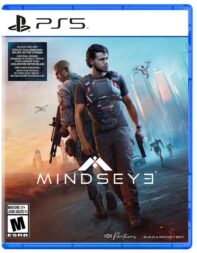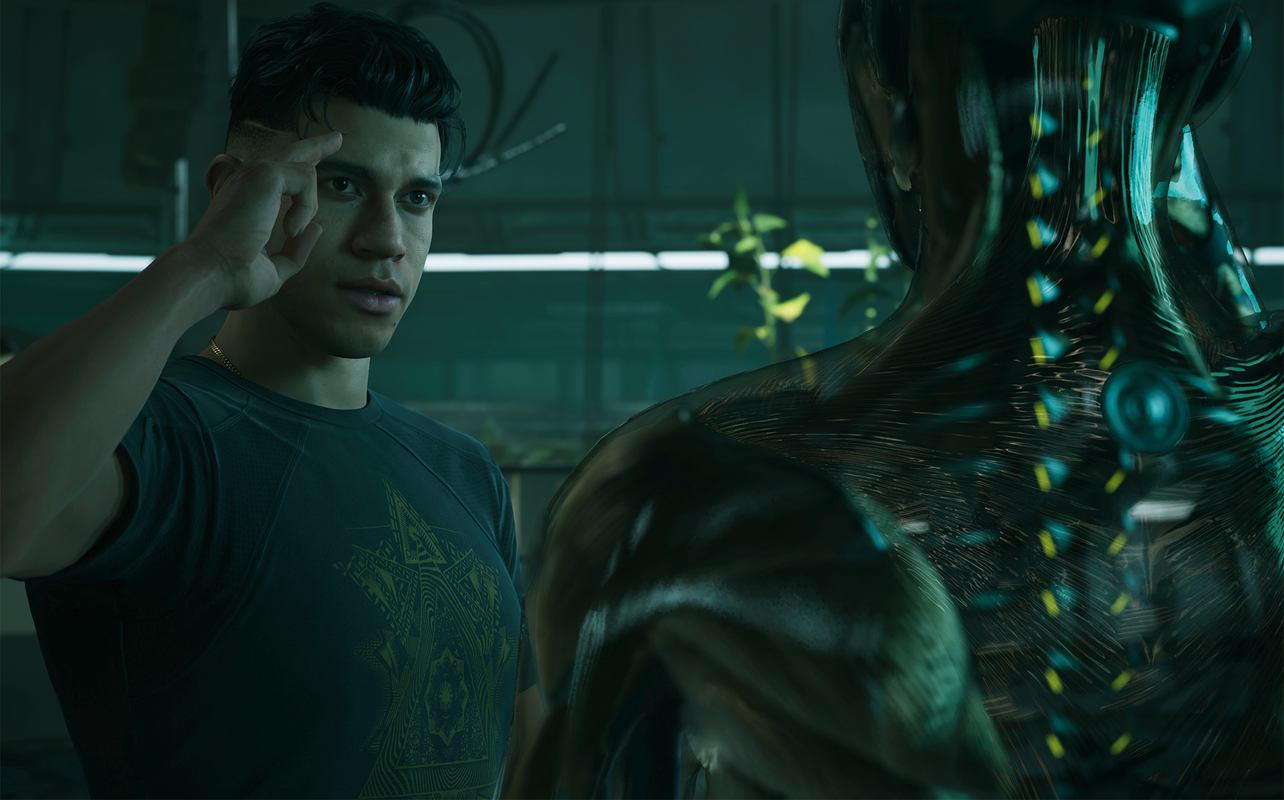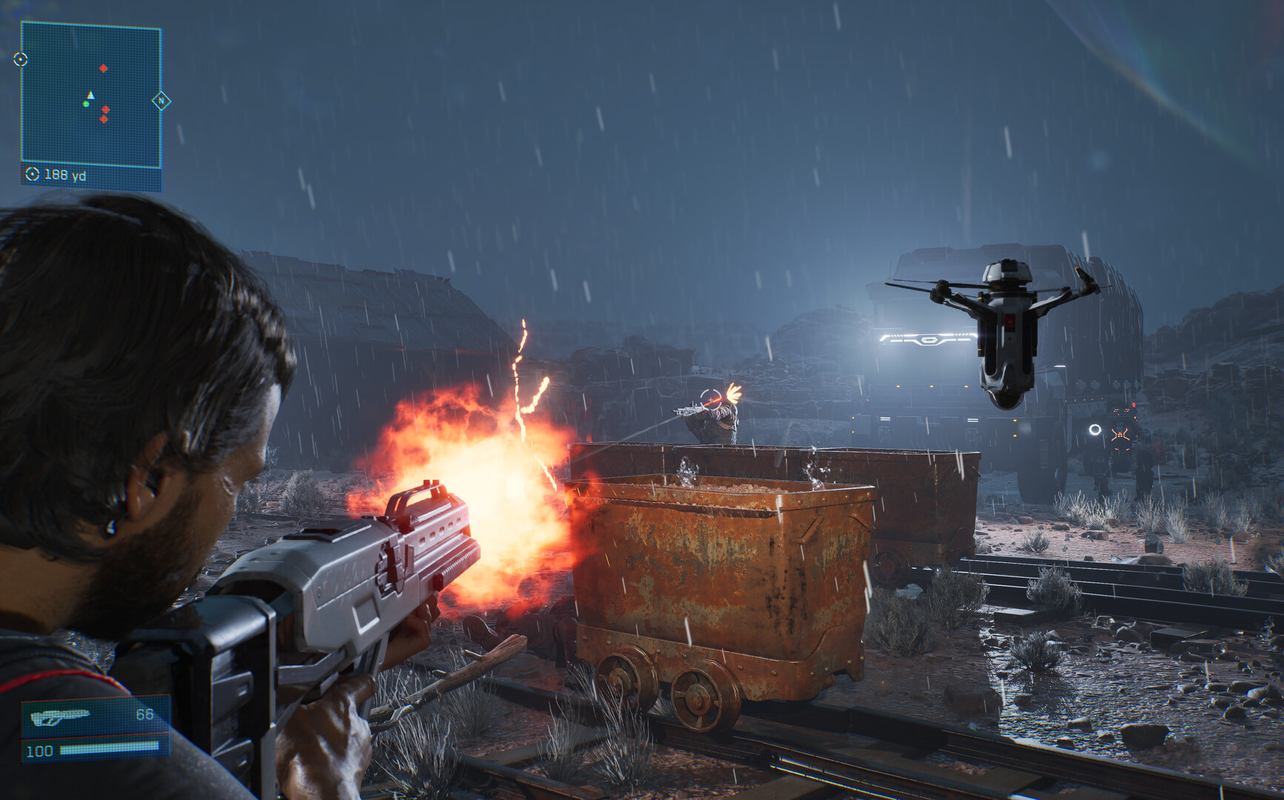
When Mindseye was first shown, it looked like it had real potential. A cyber-noir setting, memory loss mystery, and the former producer of Grand Theft Auto leading the charge? That sounded like a winning mix. But once I started playing, it didn’t take long for the cracks to show.
The game follows Jacob Diaz, a former soldier with a mysterious implant and no memory of how it got there. He takes a job at a powerful tech company and quickly ends up caught between corrupt politicians, corporate agendas, and a growing conflict in Redrock City. The setup is familiar, but I was open to seeing where it would go.
Mindseye falls short of that ambition. It tries to blend cinematic storytelling, open-world exploration, and community-driven missions, but none of it feels finished. The combat is basic, the world feels empty, and technical issues never stop piling up. That said, a few things do work, especially the visuals and voice acting.
We’ll look at what Mindseye does well, where it stumbles, and if it’s worth your time. If you were expecting the next big narrative action game, like many others were, you may want to reset your expectations.

MindsEye details
Platform(s): PlayStation 5, Xbox Series X|S and PC
Developer(s): Build A Rocket Boy
Publisher(s): IO Interactive
Genre: Action, Adventure
Modes: Single-player
ESRB Rating: M (Mature 17+)
Uncovering the past but not much else
Mindseye kicks things off with a promising setup. Jacob Diaz is a former special forces soldier with missing memories and a neural implant called the Mindseye. After settling in Redrock City, he takes a low-level security job at Silva Corp, a powerful tech company tied to the city’s leadership. It doesn’t take long before he’s pulled into a conspiracy involving the mayor, the corporation, and a growing political crisis.
On paper, it all sounds like it should work. The themes (corruption, surveillance, and AI control) are familiar but still relevant. You get bits of military trauma, personal revenge, and political stakes. There’s enough here for a strong character-driven narrative. The problem is execution. Events happen quickly with little build-up, and major developments feel rushed. The pacing doesn’t give you time to settle into the world or care about the people in it. Jacob is interesting thanks to the voice work, but the supporting cast never rises above generic roles.
Conversations are a weak spot. They jump between sarcastic banter and exposition, often in the middle of high-stakes scenes. The tone feels off, especially during missions that should carry emotional weight. By the time the story ends, it feels like it’s out of steam. There’s no real payoff, just a quick wrap-up that leaves too many threads dangling. What’s here could have worked with more time and focus. The ideas aren’t the issue. It’s the delivery. You can see what they were aiming for, but the story ends up feeling rushed, familiar, and forgettable.

Point, shoot, repeat
Mindseye sticks to a simple third-person cover shooter formula. You take cover, pop out, shoot a few enemies, and move on. There’s no melee, no stealth, no variety in how fights play out. Most missions use the same loop, and the enemy AI doesn’t help. Enemies either rush straight at you or hide in cover and peek until they’re shot.
Weapons don’t feel satisfying to use. They sound soft and lack feedback. Even the heavier guns, which show up near the end of the game, don’t change how you approach combat. There’s no weapon progression or system that encourages you to try different strategies. In one mission, I had to drive into the desert, wipe out a gang, then listen to comms chatter the whole way back. The same structure repeats often. It feels like filler, not something designed to keep you engaged. One stealth-focused mission involving a small drone showed a glimpse of variety, but it’s a one-off.
Driving is better than expected. It’s responsive and has weight, similar to GTA V. It’s one of the few parts that feels smooth. But there’s not much reason to explore the city. You’re either going to a waypoint or returning from one. The open world doesn’t give you anything to do between missions. There’s also a free play mode where you can try developer-made or community missions. These are short challenges, like races or enemy waves. The creation tools are flexible, but the early content is barebones.
Combat works, but that’s about it. If you’ve played a third-person shooter from 15 years ago, you’ve seen everything Mindseye offers. And you’ve likely seen it done better.

Looks can be deceiving
Mindseye makes a strong first impression. The cutscenes are easily the best part of the game’s presentation. Facial animations are detailed, camera angles are well-framed, and the lighting work stands out during night scenes. It’s clear the cinematic side of the game got the most attention. Redrock City looks impressive at first. It has scale, with tall buildings, desert stretches, and glowing signs that give it a futuristic vibe. But once you explore it, the world feels lifeless.
NPCs follow basic patterns, rarely react to your actions, and often break immersion. There’s no real interactivity, and you’ll notice the lack of polish the longer you play. Pop-in is a constant issue. Cars, textures, and objects often appear late, even when driving slowly. Frame rates hover around 30 frames per second, and cutscenes stutter often. Voice acting is one of the few areas that holds up. Jacob’s performance stands out and helps keep the story grounded. The rest of the cast is fine, though the dialogue they’re given doesn’t always help. Music is forgettable. It plays in the background without adding anything to the scenes or atmosphere.
Presentation wise, Mindseye shows potential. The world design looks great from a distance, and the cutscenes are well made. But the lack of polish, bugs, and weak world detail bring everything down. It looks finished until you start moving. Then it quickly falls apart.

Mindseye feels ambitious but unfinished
There’s no denying Mindseye had potential. A futuristic setting, cinematic presentation, and a story-driven approach from a team led by a former GTA producer sounded promising. But after finishing the campaign and spending time in the world, it’s clear the game wasn’t ready. The core idea could have worked. Jacob Diaz’s story had room to grow, and the visuals in the cutscenes are impressive. Voice acting is strong in key moments, and some missions offer creative setups. Driving also feels good, and the world looks polished from a distance.
| Pros | Cons |
|---|---|
| Cutscenes are visually impressive and well-directed. | Combat is repetitive and lacks variety. |
| Driving feels smooth and responsive. | Enemy AI is weak and often unresponsive. |
| Jacob’s voice acting stands out and feels grounded. | The open world feels empty and lifeless. |
| The user-generated mission tools show creative potential. | Frequent bugs and frame rate issues affect performance. |
| The story feels rushed with a flat ending. |
That impression fades fast. Combat is basic. Mission design repeats the same formula. The open world feels empty, with little to discover or do. Technical problems show up constantly, from stuttering cutscenes to pop-in and frame drops. User-generated content is included, but it feels separate from the main experience. While the tools offer potential, the early content is limited and doesn’t add much if you’re already finished with the campaign.
Overall assessment of Mindseye
Gameplay: 2/5
Graphics: 3/5
Sound: 2.5/5
Lasting appeal/Replayability: 2/5
Overall rating: 2.4/5 (48%)
You can see what the team was aiming for. A cinematic action game set in a tech-heavy future with room for player creativity. But what they released feels unfinished, unbalanced, and disconnected. Maybe updates will improve it later. Right now, Mindseye is more of a missed opportunity than a solid recommendation.





